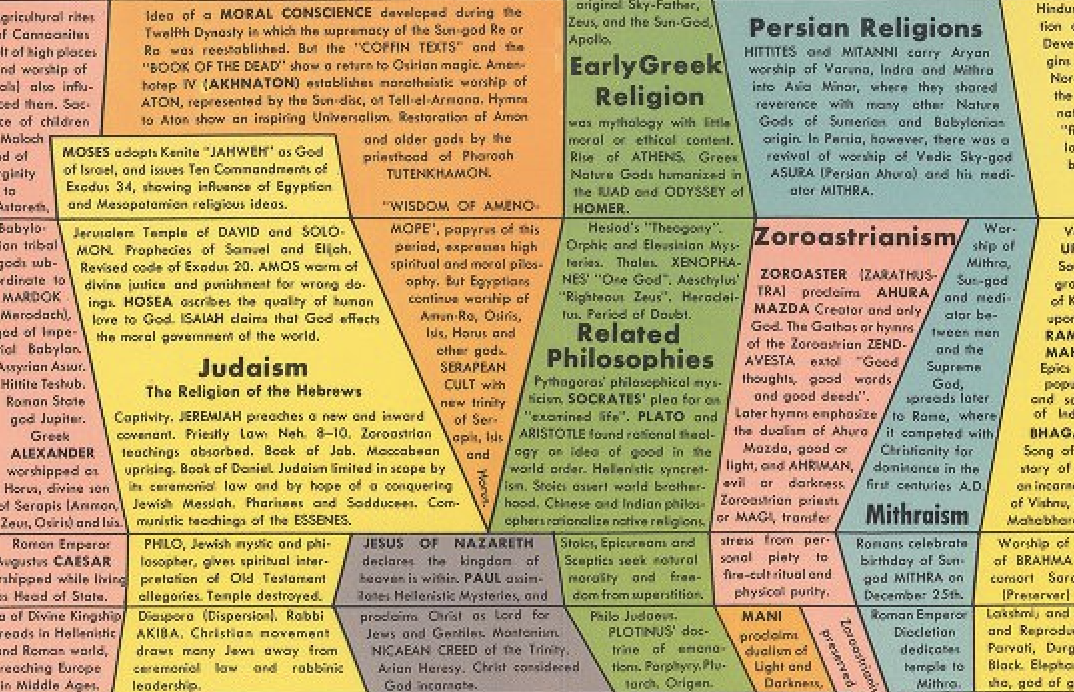
For many, even most of us moderns, the central religious choice is a simple one: adhere to the belief system in which you grew up, or stop adhering to it. But if you survey the variety of religions in the world, the situation no longer seems quite so binary; if you then add the variety of religions that have existed throughout human history, it starts looking downright kaleidoscopic. Or rather, it looks something like the faintly psychedelic but also information-rich Histomap of Religion above, created in 1943 by chemist John B. Sparks, whom we’ve previously featured here on Open Culture for his original Histomap depicting 4,000 Years of World History and his subsequent Histomap of Evolution.
The UsefulCharts video below explains Sparks’ Histomap of Religion in detail, but it also cites his Histomap of Evolution, an example of how his worldview fails to align with current perceptions of these subjects. Even the newer Histomap of Religion is by now more than 80 years old, during which time scholarship in religion and related fields has made certain discoveries and clarifications that necessarily go unreflected in Sparks’ work. But if you bear this in mind while looking at the Histomap of Religion, you can still gain a new and useful perspective on how the beliefs that mankind has held highest have changed and intermingled over the millennia.
The chart begins in prehistory, dividing the then-extant faiths into the categories “magic and fetishism,” “tabu and totemism,” “ancestor worship,” “tribal gods and divine kings,” “propitiation of nature spirits,” and “fertility cults.” Though Sparks’ information may on the whole be “based on theories about the origins of religion which have now been either rejected or at least seriously revised,” explains UsefulCharts creator Matt Baker, “the general ideas expressed by these six types are still somewhat valid.” The expansion and contraction of adherence to these types of early religion through time are reflected by changes in the width of the colored columns that represent them. Follow these columns downward through history, and new, more familiar religions emerge: Taoism, Judaism, Hinduism, Buddhism, Christianity both Catholic and Protestant.
Thereafter come other movements and figures perhaps not immediately recognizable as religious in nature: “humanism,” for example, whose representatives include Shakespeare and Rousseau. Later, the ideas of Russian intellectuals Vissarion Belinsky and Alexander Herzen branch off to become, after about a century, the “corrupt philosophy” of communism, with its “God-less propaganda” supporting a “police state aimed at world domination.” Baker objects that, if Sparks counts communism as a religion, then surely he should count capitalism as a religion as well. This is a fair-enough point, though behold this dense chart of “cults, faiths, and ethical philosophies” long enough, and you’ll start to wonder if everything humanity has ever done isn’t, in some sense, ultimately religious in nature.

Related content:
Animated Map Shows How the Five Major Religions Spread Across the World (3000 BC — 2000 AD)
The Tree of Languages Illustrated in a Big, Beautiful Infographic
4000 Years of History Displayed in a 5‑Foot-Long “Histomap” (Early Infographic) From 1931
10 Million Years of Evolution Visualized in an Elegant, 5‑Foot Long Infographic from 1931
Based in Seoul, Colin Marshall writes and broadcasts on cities, language, and culture. His projects include the Substack newsletter Books on Cities, the book The Stateless City: a Walk through 21st-Century Los Angeles and the video series The City in Cinema. Follow him on Twitter at @colinmarshall or on Facebook.


How did you get 180,000 years? What is the evidence considered?
The person who created the map got 180,000 years. You would need to ask him. Unfortunately he died in 1949.
The religion is not the “man’s search for spiritual unity”, but is the man’s search for God. The search is over when the God revelate Himself in the person of Jesus Christ.
John,
That may be very true for you, but that is by no means true for everyone else.
Much though Christians would like the world to believe it, religion — with a large or small R — is not a “one-size-fits-all” matter. If it were, Islam would not be the fastest growing religion on the planet while Christianity is perhaps arguably the fastest dying religion on the planet (if attendance in most mainstream churches in the West are anything to go by).
Count yourself blessed that you found the love of God and the forgiveness of Jesus Christ (I know I count myself blessed for that), but please do not presume that everyone else should automatically feel the same way. It is dismissive to others, and arguably is far more detrimental to your cause than good for it.
After all, the Bible itself says that “they will know us by our LOVE” — not by our words. The best way we can encourage others to find their spiritual unity with God is by walking in Jesus’s shoes, not by pointing fingers like the Pharisees.
This is a fascinating map and study. Is there a way to obtain a more readable copy of it, that can be studied and discussed?